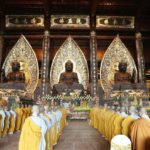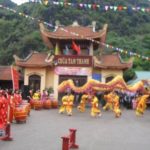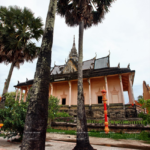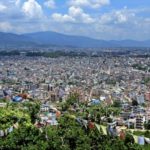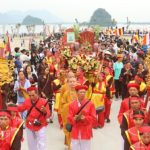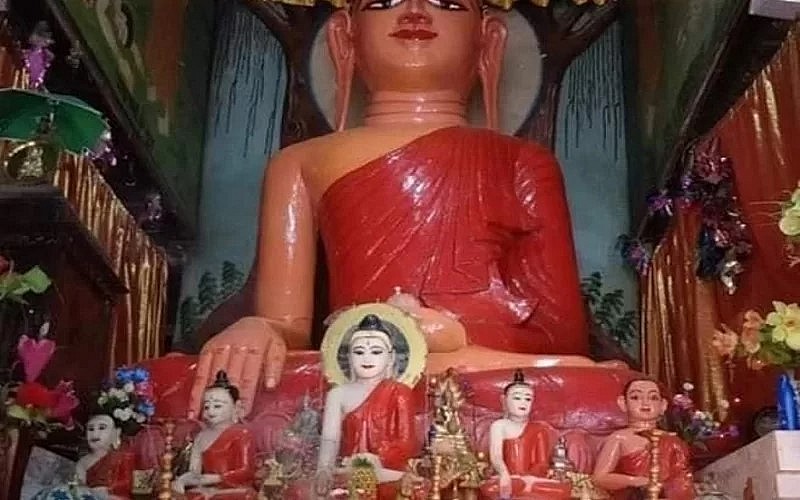 |
Boṅgabhūmi experienced its golden age of Buddhism during the reign of renowned rulers like Aśoka of the Maurya Dynasty, the Gupta Dynasty, and the Pāla Dynasty. Throughout the centuries, the construction of numerous Buddhist monasteries contributed to the spread of Buddhist wisdom throughout this vast region.
However, as time passed, the Buddhist presence in modern-day Bangladesh started to decline after the 12th century. Only a few resilient monasteries continued to preserve and uphold the teachings of Buddhism, despite facing immense challenges and adversity. One such beacon of hope is Unainpūrā Laṅkārāma, located in the village of Unainpūra, within the sub-district of Patiya and the district of Chattogram, also known as Chittagong.
Unainpūra is a spiritual village that has a unique connection to Buddhism. It is the birthplace of many Buddhist scholars, monks, and spiritual leaders who have played a crucial role in spreading Theravāda Buddhism not only in Boṅgabhūmi but also in the broader Indian subcontinent throughout centuries.
According to local historical records and a white stone rock edict that traces the monastery’s history back to the 1600s, Unainpūrā Laṅkārāma holds the distinction of being the birthplace of 16 prominent monks who have made a lasting impact on the course of Buddhism. These monks, listed chronologically, exemplify the deep-rooted connection between Unainpūra and the Buddhist tradition.
Two figures from more recent times, Ācārya Pūrṇāchār Chandramōhan Mahāsthabir (1834–1907) and his disciple, Kṛpāśaraṇa Mahāsthabir (1865–1926), stand out as influential figures in the doctrinal and institutional reconstruction of Theravāda Buddhism in contemporary Boṅgabhūmi.
Ācārya Pūrṇāchār Chandramōhan Mahāsthabir, also known as the 2nd Supreme Patriarch (saṅgharāj) of Bangladesh, remains a revered figure in the hearts of devotees, seekers, and monastics worldwide. His tireless efforts include initiatives to reform Theravāda Buddhism, ensuring its continued relevance in the modern era.
Unainpūrā Laṅkārāma is not just a historical relic, but a living testament to the enduring spirit of Theravāda Buddhism. From its esteemed leader Joydharā Mahāsthabir to the venerable Ven. Ratana Nanda Bhikkhu, the monastic community of Unainpūrā Laṅkārāma continues to uphold and pass on the teachings of the Buddha. Their unwavering dedication is mirrored by the villagers of Unainpūra, who have provided continuous support in the form of the four requisites – food, clothing, shelter, and medicine – for the monks of Unainpūrā Laṅkārāma for generations.
In recognition of its significant contributions to the preservation of Bangladeshi Buddhist practice, manuscripts, and heritage, Unainpūrā Laṅkārāma stands as a pioneering institution of Theravāda Buddhism in Boṅgabhūmi. It remains a steadfast guardian of the rich Buddhist legacy, both in the region and in India, where the echoes of Siddhartha Gautama’s teachings still resonate.
As we retrace the footsteps of the Buddha and the luminaries who followed his path, Unainpūrā Laṅkārāma reminds us of the enduring importance of this ancient tradition in a rapidly changing world, reinforcing the deep and unbreakable connection between India and Buddhism.
Mysterious Nepal
Nepal is well-known for over 50 ancient temples and palaces built from the 14th-17th centuries which are wonderful destinations for tourists to discover the mysterious country. Here are some images and stories about the temples and relics in the Buddhist sanctuary along the rivers of Bagmati Vishumati that Vietnam Pictorial’s reporter Kim Phuong would like to introduce to readers.

